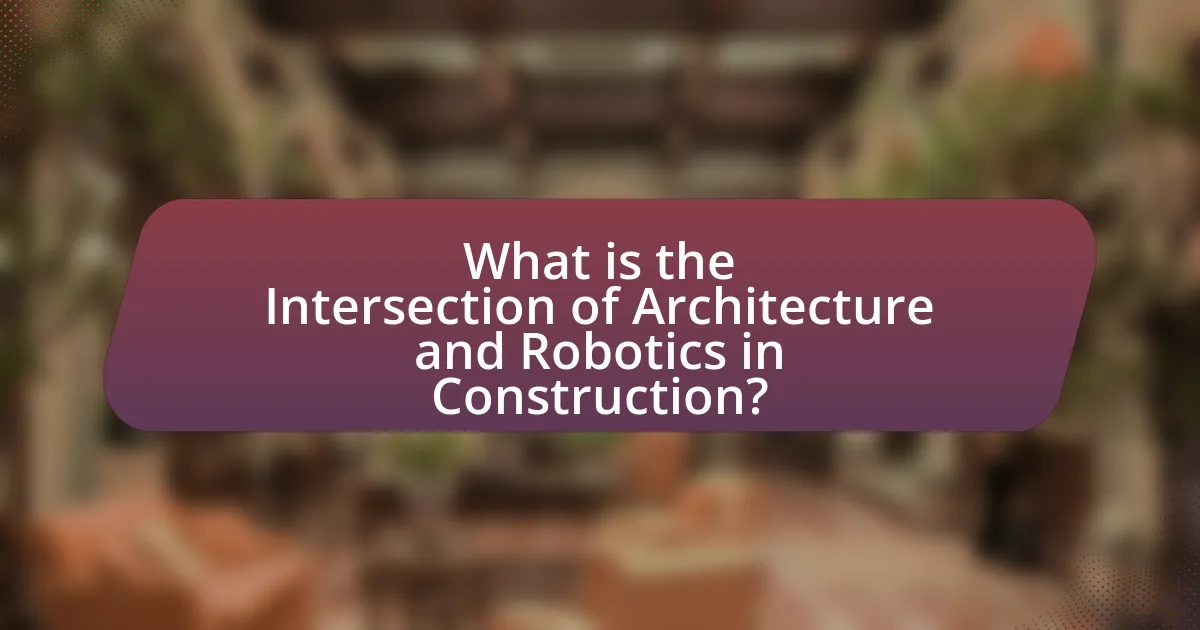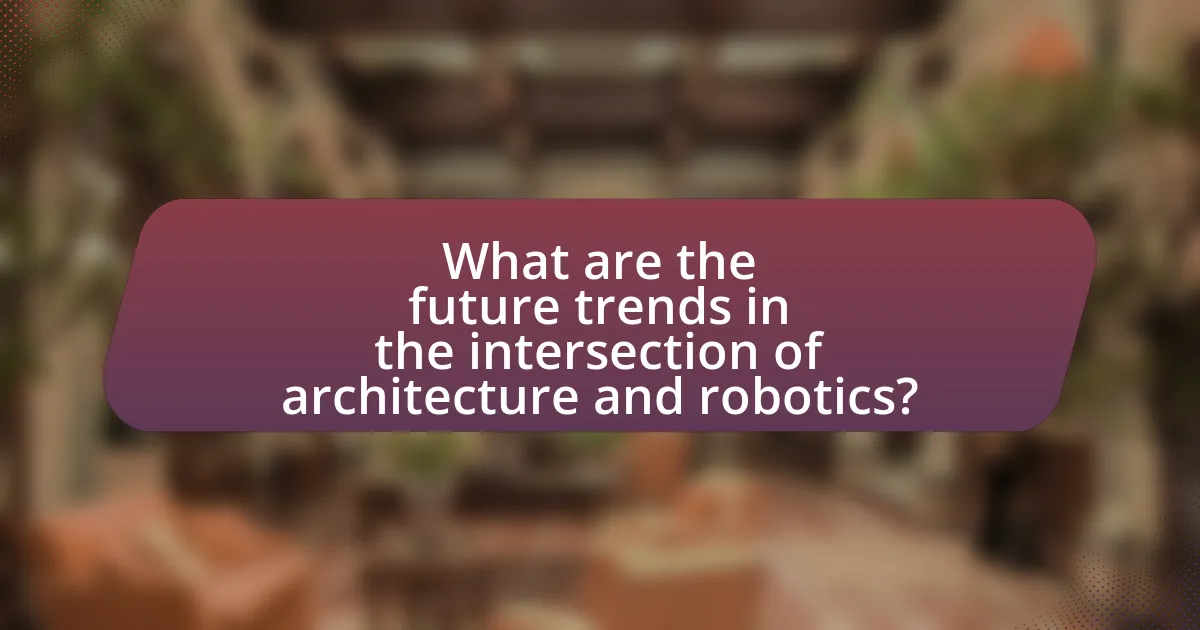The article examines the intersection of architecture and robotics in construction, highlighting how robotic technologies enhance efficiency, precision, and innovation in building processes. It discusses the collaboration between architecture and robotics, detailing key technologies such as Building Information Modeling (BIM), robotic fabrication, and artificial intelligence (AI) that facilitate this integration. The article also addresses the current applications of robotics in construction, the impact of automation on labor dynamics, and the future trends shaping the industry, while considering the challenges and ethical implications associated with robotic integration. Overall, it provides a comprehensive overview of how robotics is transforming construction practices and influencing architectural design.

What is the Intersection of Architecture and Robotics in Construction?
The intersection of architecture and robotics in construction involves the integration of robotic technologies into architectural design and building processes. This collaboration enhances efficiency, precision, and innovation in construction practices. For instance, robotic arms can automate tasks such as bricklaying and 3D printing of structures, significantly reducing labor costs and construction time. Research from the Massachusetts Institute of Technology highlights that robotic systems can improve accuracy in complex geometries, allowing architects to realize intricate designs that would be challenging to achieve manually. Additionally, the use of drones for site surveying and monitoring exemplifies how robotics can streamline project management and enhance safety on construction sites.
How do architecture and robotics collaborate in the construction industry?
Architecture and robotics collaborate in the construction industry by integrating automated systems into design and building processes, enhancing efficiency and precision. Robotics, such as drones and robotic arms, assist architects in tasks like site surveying, material handling, and even construction, allowing for real-time data collection and analysis. For instance, the use of robotic fabrication techniques enables the creation of complex architectural forms that would be difficult to achieve manually, as demonstrated by projects like the ICD/ITKE Research Pavilion, which utilized robotic arms for precise material assembly. This collaboration not only streamlines workflows but also reduces human error, ultimately leading to faster project completion and innovative design solutions.
What are the key technologies that enable this collaboration?
Key technologies that enable collaboration between architecture and robotics in construction include Building Information Modeling (BIM), robotic fabrication, and artificial intelligence (AI). BIM facilitates the integration of architectural designs with robotic systems, allowing for precise planning and execution of construction tasks. Robotic fabrication technologies, such as 3D printing and robotic arms, enable the automated construction of complex structures, enhancing efficiency and accuracy. AI algorithms optimize project management and resource allocation, improving decision-making processes. These technologies collectively streamline workflows, reduce errors, and foster innovation in construction practices.
How does this intersection influence design processes?
The intersection of architecture and robotics significantly influences design processes by enabling greater precision and efficiency in construction. Robotics allows architects to implement complex geometries and adaptive designs that would be challenging to achieve manually. For instance, robotic fabrication techniques can produce intricate components with high accuracy, reducing material waste and construction time. This integration has been validated by projects such as the ICD/ITKE Research Pavilion, where robotic systems were employed to create complex timber structures, demonstrating enhanced design capabilities and construction efficiency.
Why is the integration of robotics important in construction?
The integration of robotics is important in construction because it enhances efficiency, safety, and precision in building processes. Robotics can automate repetitive tasks, reducing labor costs and minimizing human error, which is crucial in a sector where precision is vital for structural integrity. For instance, a study by McKinsey & Company found that automation could increase productivity in construction by up to 50%. Additionally, robotics can operate in hazardous environments, thereby reducing the risk of accidents and injuries on job sites. This combination of increased productivity and improved safety underscores the significance of robotics in modern construction practices.
What challenges does the construction industry face that robotics can address?
The construction industry faces labor shortages, safety risks, and inefficiencies in project timelines that robotics can effectively address. Robotics can automate repetitive tasks, reducing the reliance on human labor, which is crucial given the projected shortage of skilled workers in the sector. For instance, a report by the McKinsey Global Institute indicates that up to 40% of construction tasks could be automated, significantly alleviating labor shortages. Additionally, robotics can enhance safety by performing hazardous tasks, thereby reducing workplace accidents; the Occupational Safety and Health Administration (OSHA) reports that construction is one of the most dangerous industries, with thousands of injuries annually. Furthermore, robotics can improve efficiency and precision in construction processes, leading to faster project completion times and reduced costs, as evidenced by a study from the National Institute of Standards and Technology, which found that construction productivity could increase by 15% through automation.
How does robotics improve efficiency and safety in construction projects?
Robotics improves efficiency and safety in construction projects by automating repetitive tasks and enhancing precision in operations. Automated machinery, such as drones and robotic arms, can perform tasks like surveying, bricklaying, and welding faster than human workers, significantly reducing project timelines. For instance, a study by the McKinsey Global Institute found that automation could increase productivity in construction by up to 20-30%.
Additionally, robotics enhances safety by taking over dangerous tasks, thereby minimizing the risk of accidents. According to the Occupational Safety and Health Administration (OSHA), construction sites are among the most hazardous workplaces, but the integration of robotics can lead to a reduction in workplace injuries. For example, robots can be deployed in hazardous environments, such as high elevations or areas with toxic materials, ensuring that human workers are kept out of harm’s way.

What are the current applications of robotics in architecture and construction?
Current applications of robotics in architecture and construction include automated bricklaying, robotic arms for prefabrication, drones for site surveying, and 3D printing of building components. Automated bricklaying robots, such as those developed by Fastbrick Robotics, can lay bricks with precision and speed, significantly reducing labor costs and construction time. Robotic arms are utilized in prefabrication processes to assemble complex structures off-site, enhancing efficiency and quality control. Drones equipped with cameras and sensors are employed for aerial site surveys, providing real-time data and improving project management. Additionally, 3D printing technology allows for the creation of intricate building elements, enabling innovative designs and reducing material waste. These applications demonstrate the transformative impact of robotics on the construction industry, leading to increased productivity and sustainability.
How are robotic systems being utilized in building design and construction?
Robotic systems are utilized in building design and construction primarily for automation, precision, and efficiency. These systems perform tasks such as 3D printing of building components, robotic assembly, and site surveying. For instance, robotic arms can fabricate complex structures with high accuracy, reducing material waste and labor costs. Research from the Massachusetts Institute of Technology highlights that robotic construction methods can decrease project timelines by up to 30% while enhancing design flexibility. Additionally, drones are employed for aerial site inspections, providing real-time data that improves decision-making and safety on construction sites.
What types of robots are commonly used in construction tasks?
Commonly used robots in construction tasks include autonomous drones, robotic arms, and mobile construction robots. Autonomous drones are utilized for site surveying and monitoring, providing aerial views and data collection. Robotic arms are employed for tasks such as bricklaying and concrete pouring, enhancing precision and efficiency. Mobile construction robots, like those designed for material transport, facilitate logistics on job sites. These robots improve productivity and safety, as evidenced by a study from the International Journal of Advanced Robotic Systems, which highlights a 30% increase in efficiency when integrating robotic systems into construction workflows.
How do these applications vary across different construction projects?
Applications of robotics in construction vary significantly based on project type, scale, and complexity. For instance, in residential construction, robotics may focus on tasks like bricklaying and framing, enhancing efficiency and precision. In contrast, large-scale infrastructure projects, such as bridges or highways, often utilize robotics for tasks like surveying and material handling, which require advanced automation and coordination. Additionally, specialized applications, such as robotic arms for prefabrication in modular construction, demonstrate how project requirements dictate the specific robotic technologies employed. These variations are supported by industry reports indicating that the adoption of robotics can lead to productivity increases of up to 30% in specific construction tasks, highlighting the tailored approach needed for different project types.
What role does automation play in modern construction practices?
Automation plays a crucial role in modern construction practices by enhancing efficiency, accuracy, and safety. Automated systems, such as robotics and drones, streamline tasks like surveying, material handling, and assembly, significantly reducing labor costs and project timelines. For instance, a study by McKinsey & Company found that automation could increase productivity in construction by up to 50%. Additionally, automation minimizes human error, leading to higher quality outcomes and safer work environments, as evidenced by the use of robotic arms in prefabrication processes that ensure precision in component assembly.
How does automation impact labor dynamics in the construction industry?
Automation significantly alters labor dynamics in the construction industry by increasing efficiency and reducing the demand for manual labor. The integration of robotic systems and automated machinery allows for faster project completion and improved precision in tasks such as bricklaying, concrete pouring, and site surveying. For instance, a study by McKinsey & Company indicates that automation could increase productivity in construction by up to 20-30%. This shift leads to a reallocation of labor, where skilled workers are needed for oversight and maintenance of automated systems rather than traditional manual tasks. Consequently, while some low-skilled jobs may diminish, there is a growing need for workers with technical skills to manage and operate advanced technologies.
What are the implications of automation for project timelines and costs?
Automation significantly reduces project timelines and costs in construction by streamlining processes and minimizing human error. For instance, automated machinery can perform tasks such as bricklaying and concrete pouring at a faster rate than manual labor, leading to shorter construction periods. A study by McKinsey & Company found that automation could increase productivity in construction by up to 50%, which directly correlates with reduced labor costs and faster project completion. Additionally, automation helps in precise resource management, reducing material waste and further lowering overall project expenses.

What are the future trends in the intersection of architecture and robotics?
Future trends in the intersection of architecture and robotics include increased automation in construction processes, the use of robotic fabrication techniques, and the integration of artificial intelligence for design optimization. Automation is expected to enhance efficiency and reduce labor costs, as robots can perform repetitive tasks with precision. Robotic fabrication techniques, such as 3D printing and robotic arms, allow for innovative building forms and materials, enabling architects to explore complex geometries that were previously difficult to achieve. Additionally, artificial intelligence will facilitate data-driven design processes, allowing architects to create more sustainable and responsive buildings by analyzing environmental impacts and user needs. These trends are supported by advancements in technology and growing demand for sustainable construction practices.
How is technology evolving to enhance the role of robotics in construction?
Technology is evolving to enhance the role of robotics in construction through advancements in artificial intelligence, machine learning, and automation. These technologies enable robots to perform complex tasks such as bricklaying, welding, and 3D printing with greater precision and efficiency. For instance, the use of AI algorithms allows robots to adapt to changing environments on construction sites, improving their ability to work alongside human laborers. Additionally, innovations in sensor technology and real-time data analytics facilitate better decision-making and coordination among robotic systems, leading to increased productivity and safety. According to a report by McKinsey & Company, the construction industry could see productivity gains of up to 20% through the integration of robotics and automation technologies.
What innovations are on the horizon for robotic construction tools?
Innovations on the horizon for robotic construction tools include advancements in autonomous robotics, 3D printing technologies, and AI-driven project management systems. Autonomous robotics are being developed to perform complex tasks such as bricklaying and concrete pouring with increased precision and efficiency. For instance, companies like ICON are utilizing 3D printing to construct entire homes in a fraction of the time and cost compared to traditional methods. Additionally, AI-driven systems are enhancing project management by optimizing workflows and resource allocation, as evidenced by research from Stanford University, which highlights the potential for AI to reduce construction delays by up to 30%. These innovations are set to revolutionize the construction industry by improving productivity, reducing labor costs, and minimizing waste.
How might future architectural designs leverage robotic capabilities?
Future architectural designs will leverage robotic capabilities by integrating automation for construction processes, enhancing precision, efficiency, and safety. Robots can perform tasks such as 3D printing of building materials, enabling complex geometries that traditional methods cannot achieve. For instance, the use of robotic arms in prefabrication allows for rapid assembly and reduces human error, as demonstrated by projects like the ETH Zurich’s “Digital Fabrication Lab,” which showcases robots constructing intricate structures with high accuracy. Additionally, drones can be utilized for site surveying and monitoring, providing real-time data that informs design adjustments and optimizes resource allocation. This integration of robotics not only streamlines construction but also promotes sustainable practices by minimizing waste and energy consumption.
What are the potential challenges and limitations of robotics in construction?
The potential challenges and limitations of robotics in construction include high initial costs, limited adaptability to complex environments, and regulatory hurdles. High initial costs can deter investment, as advanced robotic systems require significant capital for development and deployment. Limited adaptability arises because many robotic systems are designed for specific tasks and struggle to adjust to the variability of construction sites, which often involve unpredictable conditions. Regulatory hurdles can impede the integration of robotics, as existing safety and labor regulations may not accommodate automated systems, leading to delays in implementation. These challenges highlight the need for ongoing research and development to enhance the effectiveness and acceptance of robotics in the construction industry.
What ethical considerations arise from using robotics in construction?
The ethical considerations arising from using robotics in construction include job displacement, safety concerns, and accountability for errors. Job displacement occurs as automation may replace human labor, leading to unemployment in the construction sector. Safety concerns arise from the potential for robotic systems to malfunction or cause accidents, which raises questions about the adequacy of safety protocols. Accountability for errors becomes complex when robotics are involved, as it can be unclear whether the responsibility lies with the manufacturer, the programmer, or the construction company. These considerations highlight the need for ethical frameworks and regulations to address the implications of integrating robotics into construction practices.
How can the construction industry address the limitations of current robotic technologies?
The construction industry can address the limitations of current robotic technologies by investing in advanced AI algorithms and enhancing sensor technologies. These improvements enable robots to better navigate complex environments and adapt to dynamic construction sites. For instance, integrating machine learning can allow robots to learn from their surroundings and improve their performance over time, as evidenced by projects like the MIT Digital Construction Platform, which demonstrates how AI can optimize construction processes. Additionally, developing more sophisticated sensors can enhance robots’ ability to perceive and interact with their environment, leading to safer and more efficient operations.
What best practices should be followed when integrating robotics into construction projects?
Best practices for integrating robotics into construction projects include thorough planning, collaboration among stakeholders, and continuous training for personnel. Thorough planning ensures that the specific needs of the project align with the capabilities of the robotic systems, which can enhance efficiency and reduce costs. Collaboration among architects, engineers, and robotics experts fosters innovation and addresses potential challenges early in the process. Continuous training for personnel is essential to maximize the benefits of robotics, as skilled workers can effectively operate and maintain robotic systems, leading to improved safety and productivity on site. These practices are supported by industry reports indicating that projects utilizing robotics can achieve up to a 30% reduction in labor costs and a 50% increase in construction speed.





